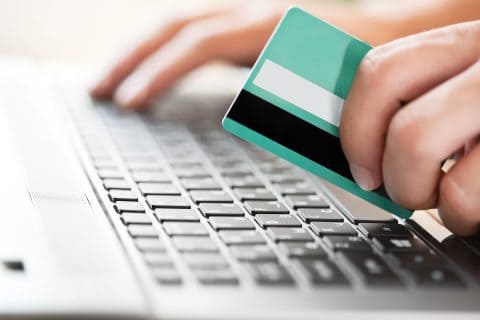Credit Card Fraud vs. Identity Theft: What’s the Difference?

Are you in danger of identity theft if someone has stolen your credit card? No. While it’s terrifying when someone steals your credit card, thankfully your identity isn’t in jeopardy — yet. Even though credit card fraud is a type of identity theft, the rest of your data may not be touched.
Though it is a hassle when someone steals your credit card info, you can continue on with your normal life without worrying about someone creating accounts in your name. It may affect your routine for a day, but it won’t ruin weeks, months, or even years of your life like identity theft could.
Here’s how you can tell these two crimes apart and fight against the thieves who are out to steal your hard-earned money.
What is Credit Card Fraud?
Credit card fraud amounted to over $21 billion in losses in 2015. Credit card fraud is a wide-range term for theft and fraud committed by using a credit or debit card as a fraudulent source of funds in a transaction. You might find out about credit card fraud by scanning your statements and noticing a charge you didn’t authorize. Fixing the problem can be extremely time-consuming and tedious, so if this ever happens to you, you could be a victim of credit card fraud.
How Does Credit Card Fraud Happen?
How do these thieves get your card information without actually physically having the card? That part is actually pretty easy, unfortunately. All they have to do is place a machine called a card skimmer on any point-of-purchase area (this is the place you swipe your card at any cash register). Skimmers are usually placed over point-of-purchase areas outside of a building, like a gas pump or an outside ATM — they’re easy to access because no employees are watching over the machine. The scariest part is that these skimmers also look just like the regular machine, so you may never know the difference.
The moment you swipe your card, the criminal has your information and can use it whenever they feel like it. Fortunately, they only have access to your card number. They don’t have your Social Security Number or your bank account information.
Sometimes thieves can also intercept your card information while you pay for something online using public Wi-Fi. Let’s say you’re ordering a new subscription box you’re excited about while waiting in line at Starbucks. A criminal can intercept your card information and use it to order something they want before your latte even gets cold.
How do You Prevent Damage?
Catching a credit card thief can be difficult, but stopping the damage is relatively simple. If caught early, you can take the appropriate protections to avoid any further loss. A fraud notice is placed on your account, and your account is monitored for unusual activity. You may be issued a new card to avoid any additional unauthorized charges.
What is Identity Theft?
Identity theft is a serious problem that’s usually split into two types: true name and account takeover. True name identity theft means that someone has stolen your personal information and used it to start a new account in your name. It can be a credit card account, mobile phone service, or checking account.
Account takeover is when an identity thief takes over the accounts that you already have: your bank account, credit cards, and more. Typically, a criminal will redirect mail to a new address and run up a massive bill before you even notice. Sounds terrifying, right?
How Does Identity Theft Happen?
There are many ways criminals can steal your personal information. As a young twenty-something, you probably get all sorts of stuff in the mail. Most of us just toss out paper copies of bills or credit card offers, especially if we know what they already say. The problem with this is that your mail can hold more critical information about you than you might think — and criminals aren’t afraid to dig through your dumpster to steal your mail, or even pop your mailbox open.
Threats can also come from an online source, like when a thief sets up a website that looks like an exact (and I mean link by link) replica of a site you usually visit. Government sites and banks are common targets, but you could also fall for a site that looks like your student loan company. Usually, you’ll sign in and when your password comes up wrong you’ll type in your Social Security Number to recall your password, and a thief now has the most important piece of data you own.
How Should You Protect Yourself?
There are some fairly straightforward steps you can take to help protect yourself from credit card fraud. Before you swipe your card, examine the point-of-purchase area. You can also switch to eco-billing, so your private information isn’t sent through the mail for a criminal to steal.
Protecting your identity, however, is a little more difficult. Not all of the power is in your hands. For example, thieves can get your identity from your doctor’s office — even if you don’t go regularly. Your address may have changed, but your Social Security Number remains the same.
One of the best ways to protect yourself from identity theft is to subscribe to a protection service, which is becoming more necessary as identity theft increases every year. Between 2014 and 2105, identity theft has risen over 47% percent. Identity theft protection services such as LifeLock, Identity Guard, and IdentityForce also help to protect your identity — even at their lowest tiers. You can get protection for as low as $20 per month.
Other than an identity theft protection service, you can decrease the chances of your identity being stolen by checking the URL of websites before typing in private information. Avoiding public Wi-Fi is also a must, as well as shredding documents with your Social Security Number or banking information on it. Purchasing virus protection and anti-keylogging software can also help protect you while surfing Instagram, Facebook, or other sites. If you do choose to subscribe to a protection service, you may even get these services included with your subscription.
Last modified on January 11th, 2018






Show Comments +